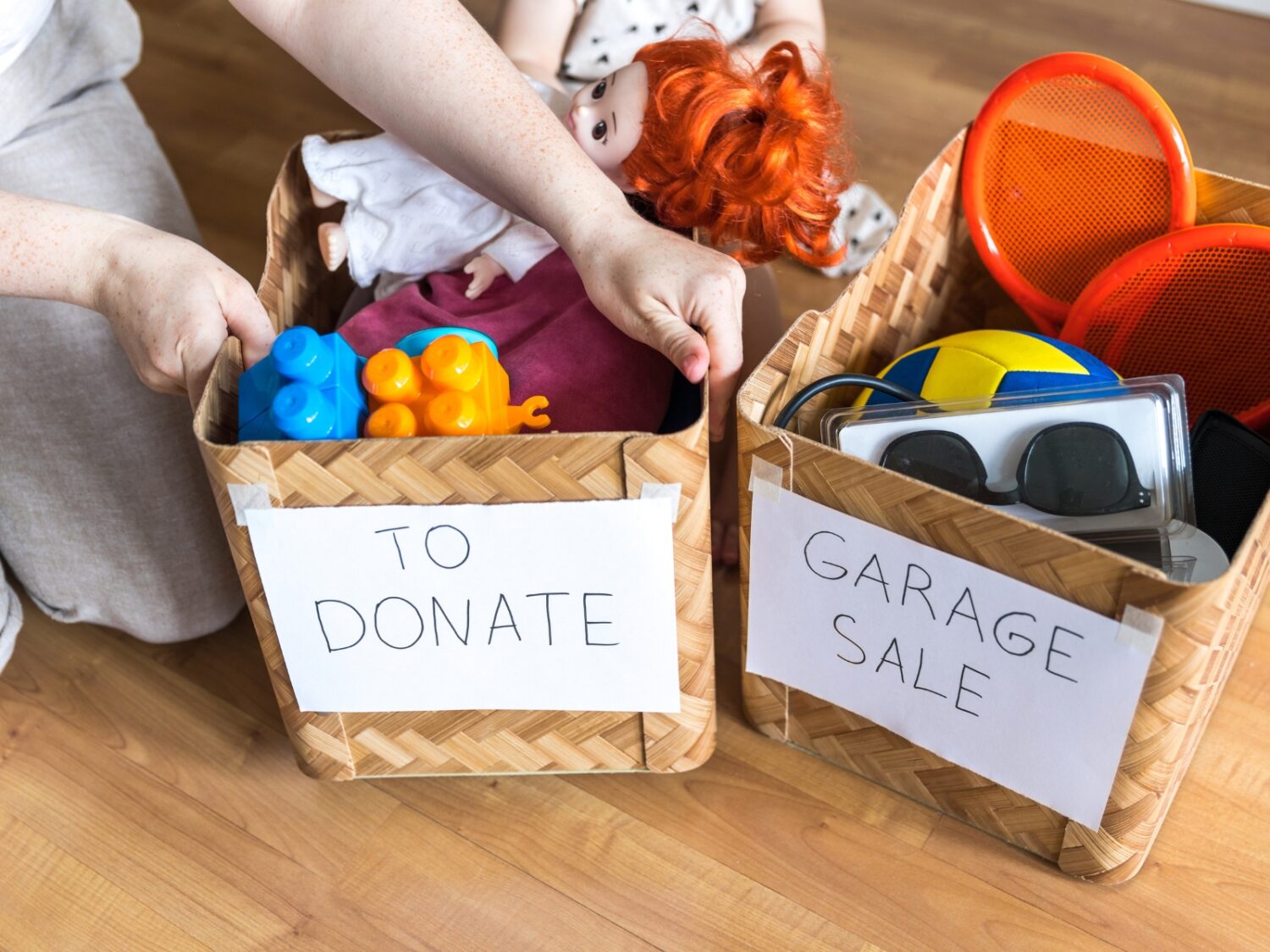Some of the links in this post may contain affiliate links for your convenience. As an Amazon associate I earn from qualifying purchases.
In a world that constantly bombards us with information and possessions, getting your space neat and organized is like giving yourself a superpower for handling life. Learning how to declutter and organize isn’t just about having a tidy home – it’s about getting ready for anything and becoming more self-reliant. Think of it as leveling up not just your space, but also your ability to handle whatever comes your way. Here’s how.

Declutter 101: How do you begin to declutter?
Step One: Choose where to declutter first
Choose the area you want to declutter. It may be an entire room, a closet, a bedroom, or a laundry room. I’ll be using the example of the kitchen, but the plan works for just about everywhere else.
If that’s overwhelming, then go smaller. Choose a drawer or a cupboard or even one shelf of one cupboard. (Try this junk drawer challenge, too!) Choose something you can easily finish. No shame here! I want you to feel successful, because that will motivate you to continue. Personally, I use this strategy even if I’m not feeling overwhelmed, because I often find that I do more simply because of I more quickly see the impact of my work.
If you have one, I wrote a whole article about how I organized my emergency supplies closet for quick and easy access.
Pro Tip: Choose an area to declutter that you can easily finish. You’ll feel successful and that will motivate you to continue.
Step Two: Gather containers
What will you put items you’re not keeping in? Gather boxes or boxes and label them. I also like to make sure my car is ready to receive donation boxes so I can load them up and take them away the next time I run errands.
Step Three: Prioritize items
The goal here is to prioritize items. Ask yourself what is most important and frequently used, and what is never used, is broken, dated, worn out, or otherwise useless but still taking up space. Alright, here goes.
- Take out everything so you can see it all at once. (Caution: If you’re doing a whole room and have a lot of stuff, this could demoralize you. I suggest starting smaller.)
- Start pulling items you no longer need or use, or that are duplicates you don’t need. Put them in a box. When the Donate box is full, take it out to your car. See Step Two. Keep the Yard Sale box in your garage if possible.
- You may need more than one of some items, and that’s okay. No one is saying only keep one plate or one pot! But if you have extra plastic plates left from when your kids (now in middle school) were toddlers, toss ’em in the box.
Step Four: Collect specialty items
Pick out things you use rarely but regularly, at least a couple of times a year, such as a gravy boat, or in my case, a potato masher, and store them in the hardest to reach cabinets. I have mine in a small transparent tote on the top shelf of my pantry.
They’re still accessible for the times when you really need that specialty item or, perhaps, an item with sentimental value, but it isn’t taking up space in areas that are easiest to access.
Pro Tip: Store items you use rarely but regularly–perhaps only on a seasonal basis–in the hardest to reach cabinets.
Step Five: Put away commonly used items
Now take the things you use most and put them in the cabinet, drawer, or shelf most convenient to where you use them. Our dishes are close to the dishwasher to make emptying it go faster. I keep pots and pans just a step or two away from my stove.
As you put each item away, evaluate whether you really need it or if you can let some go. Years, ago I got rid of my knife block; I only use chef, paring, and bread knives, plus my kitchen shears. I bought a magnetic knife rack and installed it on the wall above my food prep counter.
Step Six: Dealing with what is left
Now look at what’s left and evaluate them according to the following questions. Your answers will help you evaluate each item. It may be very hard to make some of these decisions, and in those cases, if you have the room, I recommend keeping the item. You can always decide what to do with it later. Put a reminder in your phone for six months in the future to revisit the item again.
- When was the last time I actually used it?
- Does it serve more than one purpose?
- Do I like it?
- When will I get around to finishing it?
- How much is it worth to me today?
- If I do need it down the road, how much will it cost to replace it?
If you need more help in making these choices, read more about prepping and minimalism here. While the questions in this article are geared towards minimalism, the decision-making process bears similarities.
Pro Tip: It may be very hard to make some of these decisions. In those cases, if you have the room, keep the item. You can always decide what to do with it later.
Organizing and Decluttering Tips
- Organize what is left in a way that makes sense to the person who uses it the most, whether that’s you, the kids, or your spouse. Then put it away with their help (if possible) – again, trying to keep things near where they are most likely to be used, whenever possible.
- The basic idea is to find every single item you really don’t need, want, or use – no matter how small – and get rid of them all. Don’t focus on the size of items or getting rid of “all” of something. If you have a set of 12 wine glass but now only use 4, get rid of 8 and keep the four. Don’t worry about the fact that they are a “set” – just let it go and keep what you use. How is that different from what you are usually told? Not much, but here’s the thing: even getting rid of single items – one coffee cup, one old board game, one unused throw pillow – can make a difference when you add it all up. If you think about it, just those three items would fill up a fairly standard size box. Not a big one – but that’s only three items, and you can probably find more than that in your home. That gives you either plain old empty space to enjoy, or space to put other things away so there is less clutter out and visible. Either way, it’s a win.
- Rethink the “convenience” gadgets. I vaguely remember using an electric can opener when I was in high school (or maybe junior high?), but I have never owned one myself. A hand-held can opener is easier to wash, a good one lasts a LONG time, and they can be used camping or when the power goes out, if you’re used to an electric can opener. It also doesn’t need any counter space. Likewise, an electric carving knife has never really made sense to me for healthy people.
- If you’re struggling with where to put emergency supplies, learn about how to use every available storage space you have here.
- All of this decluttering and organizing is really going to pay off if you ever have to evacuate in an emergency. Ready more about how to organize your emergency evacuation here.
Pro Tip: It’s okay to break up a set. If you only use four wine glasses but own eight, donate the ones you don’t use.
Here’s an example of declutter to get you started
The kitchen is a common area to accumulate gadgets and things that aren’t needed. Scan the counters. If you don’t ever use your blender, why do you keep it? A stick blender is much smaller and might be all you need. Bonus: It’s cheap. Personally, I use either a whisk or a pastry blender for almost everything most people use a mixer for, so I don’t need a big fancy mixer. Other people use theirs almost daily.
Don’t keep appliances because everyone else uses them or you might use them someday. Keep them because you use them, now.
Once you’ve looked over your appliances, move on to the pots, pans, casserole dishes, etc. If you notice you have three casserole dishes but you don’t really use them often, pick your favorite and donate the rest; Put them with the appliances you’ve already selected to give away or sell. Oh, and don’t forget to toss the owner’s manuals, if you still have them! It opens up a little more space in your home, and they’re useful for the new owner.
What about your serving dishes – the gravy bowl, platters, soup tureens, and all those other specialty items, even the electric carving knife. Do you still use them? If so, great! If not…box ’em up.
The same goes for your cups, plates, bowls, and utensils (for eating, serving, and cooking). If you don’t use them all, get rid of what you no longer need.
Finally, look for items in the hard to reach cupboards that none of us really use. Maybe yours contain personalized goblets you received as a wedding gift . Do you seriously still care about those,or the personalized plate with your wedding date that has never ever been out of that over-the-fridge cupboard? Trust me, I know it may be hard, but just let it go.
I kept the unity candle from our wedding for 15 years. Why?? ( Wait! Instead of donating it, repurpose it as emergency lighting in your power outage kit.)
Clutter costs you money! $$$
We used to live in Los Angeles and at one point, our house was worth over $500 per square foot. (Nope, not a typo, and that’s not the dollar amount when we bought it.) That meant that buying a Little People toy for the kids was $30 or so for the toy, plus $750 in space in our house! That made it nearly an $800 toy, which was far more than I was willing to pay for it.
Your housing (and ours, now) is probably far less expensive, but even if it’s $100 per square foot, is that old chair you are keeping because, well, you aren’t quite sure why, really worth $400+ in home space to you? Or could you dump it and buy a chair you actually like later, if you ever actually need it?
The cold hard fact is that there is cost involved when it comes to clutter. You need a bigger and bigger house to hold it all. Sometimes it is worth it. I stand by my choice to stuff a closet with cardboard boxes of my son’s clothing to keep for my younger son, but I am ruthless about donating anything they outgrow to charity.
How much is your clutter costing YOU?
Final Thoughts
You may not have a lot of extra items, but even removing one casserole dish, three glasses from fast food restaurants, half the contents of the kitchen junk drawer, and those old kiddy plates and sippy cups your children outgrew years ago can free up a surprising amount of room, making it easier and more pleasant to put things away.
It’s great if you can get rid of some big things, but just getting rid of little bits and pieces can shake free a surprising amount of space in your home and get you started on the path of decluttering you home.
Keep what’s most important and get rid of the dozens of items that are cluttering your home and your life.
What’s you favorite strategy to declutter and organize your home?
Originally published 1/21/2015.



















